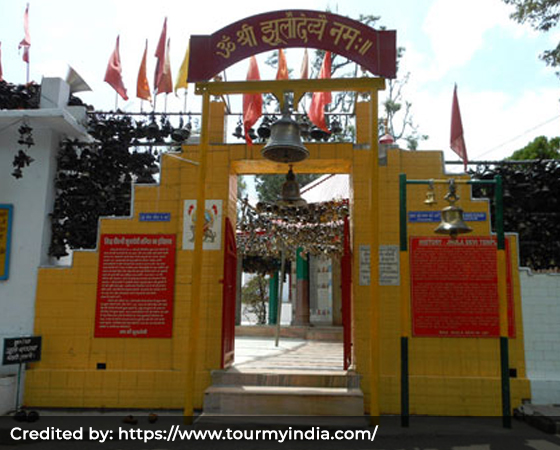Jhula Devi Temple
Click the 'Play' button to read out loud this webpage content
Introduction to Jhula Devi Temple
Jhula Devi is an old temple located in Chaubatia Gardens, Uttarakhand. It lies among the Kumaon Himalayan ranges. Pilgrims from across the world visit the highly revered Hindu temple. It is one of the main attractions of Ranikhet. Maa Durga is the presiding deity of the temple. Since she sits on a wooden Jhula (swing), the temple is named Jhula Devi Temple. Amidst stillness and harmony, the Jhula Devi Temple invites pilgrims and explorers to feel a unique experience.
Legend of Jhula Devi Temple

The residents of Chaubatia were living under the fear of attack by wild animals like Tigers and Leopards that roamed in the dense forest surrounding it. They prayed to Maa Durga for protection from the wild animals which attacked people and killed their livestock.
Responding to their prayers, Maa Durga appeared in a shepherd's dream. She asked him to excavate a particular place. He followed her instructions, found an idol, and constructed a temple there. And the deity was also installed in that temple. It is said that after this, attacks by wild animals reduced.
The deity again appeared in the Shravan month (July-August) and asked for a Jhula (swing) for herself in the same region. The devotees installed a wooden swing inside the temple's sanctum sanctorum and kept the idol on it. People in the region strongly believe that Maa Durga protects them from all wild animals. Although this is a forest area that is home to many dangerous animals, the local residents and their cattle roam about freely as they believe that the Goddess will protect them from harm.
The Architecture of Jhula Devi Temple
The Katyuri rulers who ruled Kumaon region from the 7th to the 11th century AD supposedly built the temple. The Chand dynasty, which ruled Kumaon from the 11th to the 18th century AD, renovated the temple. Today, the Jhula Devi Temple Trust maintains it. One can find many bells hanging on its premises. The present temple was reconstructed in 1935.
The architecture of Jhula Devi Temple features the traditional Kumaoni style. The temple stands on a raised platform. The temple has a main door of iron with a sturdy brass handle. A cluster of small to big brass bells hangs from the temple's entrance. Intricate carvings adorn the doors. The temple roof is sloping and is made of slate tiles. The wooden pillars support the roof.
Jhula Devi blesses her devotees from the sanctum sanctorum. She is in a sitting posture. Her idol is of black stone. Shimmering jewellery and silk clothes beautify her idol. Rama, Sita, and Hanuman have their separate shrines. There are statues of a lion and a mouse.
A beautiful feature of the temple is the hanging bridge. It is made of wood and iron and lies across a small stream. This bridge leads to a small courtyard where devotees offer prayers. Devotees can find a Pooja store inside the temple to buy Pooja items.
The Jhula Devi Temple's exceptional architecture and location amidst the lush green forests make it a famous destination for tourists and devotees.
Benefits of Worshipping at Jhula Devi Temple
Pilgrims tie a bell here after offering prayers to her to fulfill their wishes. Once their desires are fulfilled, they revisit the temple and tie another bell to express gratitude to the deity.
Festivals in Jhula Devi Temple
Navratri is grandly celebrated in the Jhula Devi Temple.
How to Reach Jhula Devi Temple
By Road
The nearest bus stand to Jhula Devi Temple is the Chaubatia Bus Stand. It is 5 km from the temple.
By Rail
The nearest train station is Kathgodam railway station, which is 74 km away from the temple.
By Air
The nearest airport is Pantnagar Airport. It is a 109 km distance.
Jhula Devi Temple Timings
The Jhula Devi Temple remains open from 6.00 am to 5.30 pm.
Best Time to Visit the Jhula Devi Temple
Summer is the best season to visit the Jhula Devi Temple. The temperature falls between 20°C to 40°C from April to June. So, during this time, thousands of devotees visit the temple.
If you wish to have customized spiritual tours or pilgrimages arranged in India for yourself or for a group of people, please contact Brindavan Mystic Services
Email ID: [email protected]
Toll free: 1800 102 9098